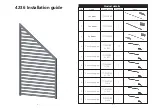
Page 15 of 89
©Retrotec 2017
4. Types of Duct Leakage Tests
Air leakage from a duct system can be very hard to identify. Most duct systems are predominantly
behind walls, in attics, crawlspaces, or other unconditioned and hard to access areas. Consequently,
most duct leaks are hard to find, and tend to go unnoticed by owners and contractors alike.
Unfortunately, the harder a leak is to find, the more crucial it tends to be, as these leaks are often found
in hot, humid, damp, and moldy environments. For more details on methods of finding air leaks in the
ducts, refer to later sections.
There are two types of duct leakage tests: a Total Duct Leakage test, and a Duct Leakage to the Outdoors
test.
Total Duct Leakage
test is used to determine the total amount of air leakage from a duct system
(to outdoors and indoors)
•
only a DucTester system is needed to create a pressure in the duct system
•
See section 8.1 for test procedure
Duct Leakage to Outdoors
test is used to determine the air leakage from a duct system to the
outdoors only
•
Both a DucTester system and a Blower Door system are needed in to create a pressure
in the duct system and the house
•
See section 8.2 for test procedure
4.1
What is duct leakage to the outdoors?
Duct systems can be either within the conditioned space (i.e., entirely enclosed in the building), or
outside of the building envelope (i.e., in crawl spaces and/or attics). When ducts are contained in the
conditioned space, air leaking from ducts will end up inside the home. When the ducts are outside of
the conditioned space, duct air leaks go directly to the outdoors; this causes conditioned supply air to
escape, and allows outdoor air to be sucked in through the return. If duct systems run within building
cavities, leaked air can go to both the outdoors and inside the house.
For Duct Leakage to Outdoors tests, the DucTester fan and Blower Door create the same pressure in the
house and the duct system. This neutralizes the pressure between the house and duct system, which
effectively means that there would be no airflow between the duct and inside the house, resulting in the
DucTester system only measuring duct leakage to the outdoors.
The studies discussed in section 1.2 mostly reference homes with duct systems outside of the
conditioned space. Duct leakage to the outdoors has the most impact on HVAC performance. However,
even when all ductwork is located within the building there can be significant loss to the outdoors.
4.2
What is duct leakage to the indoors?
Less is understood about the impacts of duct leakage to the indoors. One of the major concerns is that
leaky return systems can cause basements to depressurize, which can in turn cause combustion gases
(from the furnace) to spill into the home. This can cause serious health problems for the occupants,
especially if the gas mixture is high in carbon monoxide, an odorless, invisible gas and deadly gas. Along
with this problem, negative pressures can also cause increased moisture in the building, and possibly
allow radon gas to infiltrate as well.
Summary of Contents for DucTester 300
Page 25: ...Page 25 of 89 Retrotec 2017 ...
















































